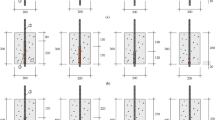Abstract
In recent years there has been an increasing interest in applying stainless steel (SS) reinforcement in concrete structures to avoid corrosion derived durability problems. Concrete-steel bond behaviour and applicability of existing standards have not yet been extensively studied with respect to SS. Moreover, an interest in applying flat rebars as reinforcement elements has emerged. The idea is based on the optimization of the rebar surface in contact with the concrete as well as on the reinforcement optimization for shallow slabs. To advance in the evaluation of the bond between concrete and flat SS strips and to compare with the behaviour of standard carbon steel (CS) round reinforcement 72 bond tests have been conducted. The test program consists of pull-out tests to centrally reinforced concrete specimens. Traditional concrete and self compacting concrete are used for embedding. For a better analysis and understanding of the failure aspect of the specimens, fluorescent epoxy injection has been conducted. Results are compared to the CEB-FIP 1990 bond model. The authors conclude that, the use of SS instead of CS is not considerably influencing the bond capacity of the reinforcement when ribbed samples are used while parameters as reinforcement shape or rib pattern are more deterministic. An adaptation of the CEB-FIP 1990 bond model is proposed for flat reinforcements tested in this work.


















Similar content being viewed by others
References
Cigna R, Andrade C, Nürnberger U, Polder R, Weydert R, Seitz E (2003) Corrosion of steel in concrete structures—final report. European Commission, COST Action 521
Markeset G, Rostam S, Klinghoffer O (2006) Guide for the use of stainless steel reinforcement in concrete structure. Norwegian Building Research Institute, Project report 405
McGurn JM (1998) Stainless steels reinforcing bars in concrete. Proceedings of the international conference on corrosion and rehabilitation of reinforced concrete structures, Orlando
Knudsen A (1998) Cost effective enhancement of durability of concrete structures by intelligent use of stainless steels reinforcement. Proceedings of the international conference on corrosion and rehabilitation of reinforced concrete structures, Orlando
Garcia-Alonso MC, Escudero ML, Miranda JM, Vega MI et al (2007) Corrosion behaviour of new stainless steels reinforcing bars embedded in concrete. Cem Concr Res 37:1463–1471
Alhborn TM, DenHartigh TC (2003) Comparative Bond Study of Stainless and High-Chromium Reinforcing Bars in Concrete. Transp Res Rec 1845:88–95
ACI 318-05 Building code requirements for structural concrete (2004)
Aal Hassan AAA (2003) Bond of reinforcement in concrete with different types of corroded bars. Master Thesis, theses and dissertations-Paper 133. Reyerson University, Toronto
Johnson JB (2010) Bond strength of corrosion resistant steel reinforcement in concrete. Master Thesis, Virginia Polytechnic and State University, Blacksburg, Virginia
CEN (2004) Eurocode 2: EN 1992-1-1: design of concrete structures—part 1-1: general rules and rules for buildings
Centre d’information sur le ciment et ses applications (2006) Béton armé d’inox. Le choix de la durée. Collection Technique CIMBéton, T.81
CEB-FIP Model Code 1990 (1993). Comité Euro—International du Béton
EN 12350 Testing fresh concrete (2009)
EN 12390 Testing hardened concrete (2009)
EN ISO 15630 Steel for the reinforcement and prestressing of concrete-Test methods-Part 1: Reinforcing bars, wire rod and wire (2010)
ISO 4287 Geometrical Product Specifications (GPS)—Surface texture: Profile method—Terms, definitions and surface texture parameters (1997)
ISO 25178 Geometric Product Specifications (GPS)—Surface texture: areal (2010)
RILEM (1970) Technical Recommendations for the Testing and Use of Construction Materials: RC6, Bond Test for reinforcing Steel. 2. Pull-out test
FIB (2000) Bond of reinforcement in concrete. State of the art report. FIB Bulletin 10
Caspeele R (2010) Probabilistic evaluation of conformity control and the use of Bayesian updating techniques in the framework of safety analysis of concrete structures. PhD dissertation, Ghent University, Ghent
CEN (2002) Eurocode 0: EN 1990: basis of the structural design
ISO 2394 General principles on reliability for structures (1998)
Goto Y (1971) Cracks formed in concrete around deformed tension bars. ACI Journal 68(4):244–251
Acknowledgments
The authors would like to acknowledge Aperam Stainless Europe (represented by Aperam Isbergues R&D) for the financial support to this project, as well as for their participation in terms of material supply. Authors are also grateful to Matiere® for their active collaboration in developing the ribbed pattern in flat reinforcement members.
Author information
Authors and Affiliations
Corresponding author
Rights and permissions
About this article
Cite this article
Ertzibengoa, D., Matthys, S. & Taerwe, L. Bond behaviour of flat stainless steel rebars in concrete. Mater Struct 45, 1639–1653 (2012). https://doi.org/10.1617/s11527-012-9862-x
Received:
Accepted:
Published:
Issue Date:
DOI: https://doi.org/10.1617/s11527-012-9862-x



